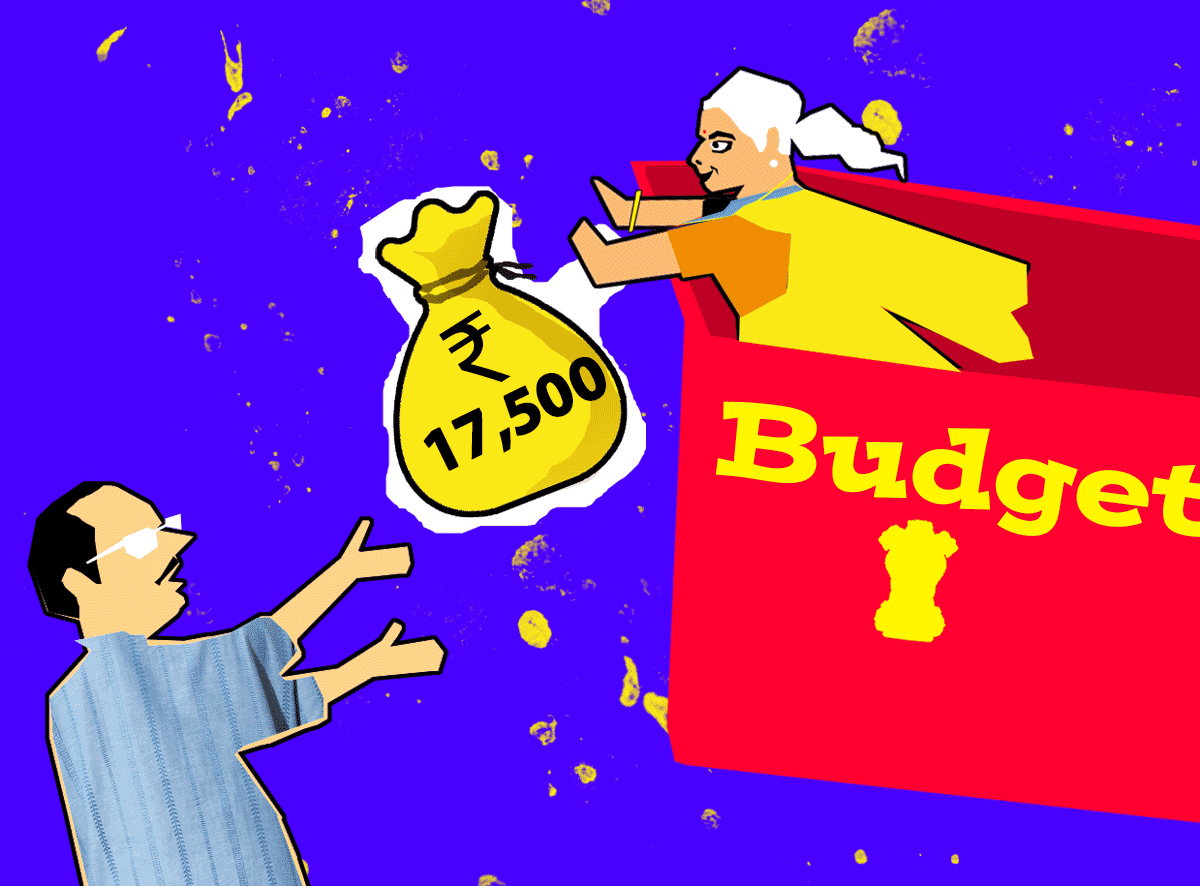Here's what experts say how taxpayers must invest Rs 17,500 and the dos and don'ts they must follow while investing this money

With the aim of putting more money into the wallets of individual taxpayers, Finance Minister Nirmala Sitharaman tweaked the tax brackets under the New Tax Regime.
The standard deduction that the salaried individuals were allowed has been increased from Rs 50,000 to Rs 75,000.
As per the tweaked New Tax Regime, those earning between Rs 3 lakh and Rs 7.75 lakh annually will be paying no tax on their annual incomes.
Those earning annual incomes above Rs 10 lakh will now be able to save Rs 17,500 in tax outgo.
Prasanna D Zore/Rediff.com spoke to registered investment advisors (RIAs) to figure out how best this extra Rs 17,500 saved ever year can be invested to create a decent corpus in the years ahead. This is what they said.
Madhupam Krishna, RIA, Jaipur
You are on a road journey and in this scorching heat you find an extra juice packet. The Rs 17,500 every year that you are going to get as tax savings is such bonus income that you will get for coming years. You better have a plan for it and make the most of it.
Financial planners do not account for bonus and inheritance money when we make a financial plan. But we often inform our client that these two income sources are expected and you should use them to the fullest to expedite your goals.
Our advice is to invest maximum to help you achieve your goals of all horizons. There are many ways to use it. Use any one or a combination to benefit your finances.
1. First, cover your risks. If you are an earning member and your family looks up to you for providing them today and in the future, you need to cover yourself with a Term Plan and a Mediclaim policy for you and family.
If you have been still waiting to buy them or if you have missed any premium on your term plan or health policy, this bonus money can be used to revive that lapsed policy.
If you already have these, we also recommend increasing your term coverage and family health policy in case it is required.
2. These annual savings can also be used to open accounts for your retirement like PPF or NPS. They can also be used to start Sukanya Samriddhi Yojna in case you have a female child below 10 years.
If you are already a subscriber to these, make top-ups to help you reach your goals early.
3. You can increase your SIP with this amount. Say today if you are 30-year-old and you start investing the savings of Rs 17,500 in monthly SIP (Rs 1,500 approximately per month), after 10, 15, 20 years you can get Rs 3.07 lakh, Rs 6.21 lakh, Rs 11.39 lakh respectively if your portfolio returns just 10 per cent CAGR. The fastest way to reach your medium to long-term goals!
4. This income tax saving can also be used to create or replenish your emergency fund. If you have dipped into it in the last year you must repay by adding the monthly installment.
5. These savings should also be used if you have missed any payment that you have an obligation to pay. For example: EMIs, credit card dues, or even payments due to family or friends should be paid back to earn a good credit profile.
The income tax savings are not a free amount. You have earned it. It is okay to gift yourself and your family some money. But investing it to save taxes, improve your credit and helping to reach your goals faster, is a smart way to manage this surprise income.
Sabhapaty Narayanan, RIA, Chennai
'Investing in equity MFs offer superior returns'
Investing in equity mutual fund will always prove better than investing in any other instruments including PPF, NPS, or even gold. Gold can beat inflation to some level but one must look to invest in equity MFs if one is hoping to earn inflation-beating returns.
Investors can expect a conservative return of 10 to 12 per cent if they stay invested for at least six to seven years. If they can remain invested for 10 to 15 years, they can definitely earn 15 per cent returns compounded annually based on historical data.
Investing in mutual funds is subject to market risks and one must invest based on their risk profile. We cannot accept everybody to invest in equity MFs.
Depending on your risk profile, once can invest 70:30 (of the Rs 17,500 saved as tax) or 50:50 in equity MFs and the rest can be in gold or PPF or other debt instruments.
But investing in MFs can always provide superior returns than going for any other mode of investing.
Instead of investing in Gold ETFs or Gold BeEs, I would rather invest only in equity MFs.
The reason is if you go for equity depending upon the market condition we go up and down, one gets better returns by investing in equity MFs not because of any magic. Investing via SIPs helps in accumulation of units over a period of time -- when the market goes up one gets fewer number of units but when the market goes down they get higher units; that way it helps in averaging the cost of accumulated MF units.
Invest in equity MFs only if you have the patience to wait for 10-15 years without any emotions when the markets rise and fall.
Kosuru Venkata Ratnasai, RIA, Nellore
'Invest only in index funds'
I would say invest only in index funds.
So if you are a beginner, start investing in broader funds that invest in Nifty or Nifty Next 50. If someone is an advanced investor, has been investing proficiently in markets then you can go for schematic funds.
If you want hands off approach then go for index funds.
It is not possible to create a corpus of Rs 50 lakh by investing just Rs 17,500 every year for the next 10 years. But the best way to use this extra money would be to invest the whole amount in the index funds so that it does compound to a great level and not just stay in the banks or one ends up spending it.
The Rule of 72
The Rule of 72 helps you calculate how much return could double your investment.
If you want to double the income in three years, you should divide 72 by three, which comes to around 24. So you need to have 24 per cent return per year if your investment has to double in three years.
Likewise, if you want to double your income in six years, you should divide 72 by six, which comes to around 12. So you need to have 12 per cent return per year if you want to double your income in six years.
Using the same calculation, a rough estimate would suggest that Rs 17,500 invested every year over a period of ten years would become Rs 3.6 lakh in ten years assuming an expected return of 10 per cent per annum.
So, if someone wants to create a corpus of, say Rs 30 lakh plus in ten years, the person would have to invest Rs 1.75 lakh every year (roughly Rs 14500 per month) for 10 years to hit the target assuming an expected return of 10 per cent per annum.
Aarathi Rajagopal, RIA, Ernakulam
'Rs 50 lakh 33 years later will only be Rs 7.7 lakh in today's terms'
I have been advising my clients to start investing as much as possible and as early as possible in SIP mode, in MFs if they want to compound their investments and retire early.
You have to put it in a long term equity fund only, the only investment that can give you 10-12-14 per cent returns in the present market condition.
One can invest in a multi-cap MF or even take the equity route via the NPS.
Most individuals have their asset allocation in place and must be already investing their moneys based on their risk profile. Now, this Rs 17,500 extra can all be put into a long term equity MF.
If somebody starts investing from 25 till the retirement age of 58 then Rs 17,500 extra invested every year (Rs 1450 per month roughly) for the next 33 years will become Rs 45 lakh to Rs 84 lakh, assuming a return of anywhere between 10 per cent to 12 per cent respectively.
But one will have to discount the rise in inflation rate of 5 per cent for the next 33 years to know what will be the future value of your corpus in today's terms. A rough calculation suggests that the value of Rs 50 lakh 33 years later will be only Rs 7.7 lakh in today's terms.
Do you have questions about mutual funds, income tax, retirement planning or investing in stocks? Ask our experts HERE
Disclaimer: This article is meant for information purposes only. This article and information do not constitute a distribution, an endorsement, an investment advice, an offer to buy or sell or the solicitation of an offer to buy or sell any securities/schemes or any other financial products/investment products mentioned in this article to influence the opinion or behaviour of the investors/recipients.
Any use of the information/any investment and investment related decisions of the investors/recipients are at their sole discretion and risk. Any advice herein is made on a general basis and does not take into account the specific investment objectives of the specific person or group of persons. Opinions expressed herein are subject to change without notice.











 © 2025
© 2025